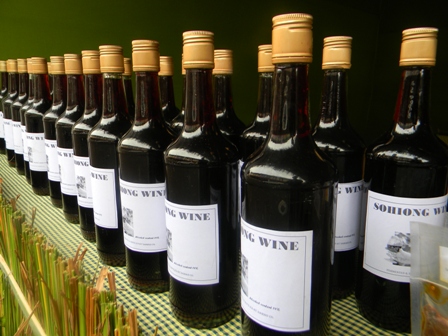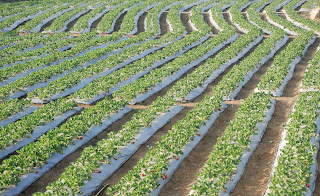In simple words, Marketing involves finding out what the customers want and supply it to them at a profit. A classical definition is the series of services of services involved in moving a product or commodity from the point of production to the point of consumption.
Agricultural Marketing involves the movement of agricultural produce from the farm till it reaches the consumer. This covers physical handling, consolidation, transport, packing, grading, sorting, cleaning and quality control to simplify sales transaction and meet different consumer’s requirement. For the farmer, the strategic function of marketing system is to offer him a convenient outlet for his produce at remunerative price.
Why Marketing is important?
The importance of good marketing can be conveniently considered from 4 different perspective of the economy, the farmer, the product and the consumer.
As societies and States developed there is a movement of people from the rural areas into towns and cities. Urban population on an expanding average grow about 4% annually. This implies that the number of people needing to be fed by the agricultural sector will double in 16 years. In addition, since the amount of food eaten by each individual normally increase as people becomes wealthier, the supply of food to towns and cities double approximately every 10-14 years.
Therefore urban markets will inevitable become bigger. In addition to improved agricultural skills, the farmers will have to take on greater commercial skills as well. This includes understanding consumer’s preferences, delivering quality produce, market oriented production etc.
Problems and Constraints in agricultural marketing:
Farmers are unorganized and have no voice to air their grievances. They are simple and are also easily exploited. Although most of the agriculture production in our State is subsistence in nature, on the other hand, if farmers are to increase production, more attention needs to be paid to the fact that their output must be marketed at a rewarding price. Therefore commercialization of the small farm sector requires the development of market oriented production as well as development of modern marketing infrastructure and facilities to handle the movement and marketing of produce in an efficient manner.
Some of the major constraints related to the development of marketing of agricultural produce in the State can be outlined below:-
1. Lack of organization: The striking feature of agricultural marketing is the lack of any kind of collective organization among the producers. The buyers of agricultural produce usually operate in an organized way. Under the circumstances, it is common to find that the producers of agricultural products are being exploited by the purchasers.
2. Forced sales: The farmer in general sells his produce at an unfavorable place at an unfavorable time and usually gets unfavorable terms. Because of poverty and subsistence nature of his farming, he usually disposes of his produces even at unremunerative prices. Specially when there is a glut in the market immediately after harvest, the prices offered are generally low. The nearest place where the farmer disposes of his produce is his village. The effective price realized by the farmer is further reduced by malpractices like under weighment, unauthorized deductions etc.
3. Superfluous Middlemen: Majority of farmers dispose of their produce in the village itself. The result is the intervention of a host of middlemen between the producers and the final consumers. This in turns create a long chain of middlemen in the marketing channels which results in higher prices for the consumers, while the producer share in consumer rupee also decrease substantially.
4. Multiplicity of market charges: The marketing charges payable by producers are numerous and varied in unregulated markets and they tend to reduce considerably the return to the producer from the sale of his produce. For instance, the farmer has to pay entry toll before his produce can be taken inside the market. Next, he has to incur carrying charges, weighing charges, commission charges etc. Further, the producer has to depend on the broker/dalal to get into contact with the commission agent/buyer. For their services he has to pay some commission. In addition to the commission, he also has to pay a number of other charges like carting /haulage, unloading the cart/basket etc.
5. Malpractices of markets: In unregulated markets, malpractices tend to be common. These are:
· Scales and Weights are manipulated against the seller. This practice is rendered easier by the fact that non-standardized weights are often used and due to absence of regular inspection by concerned authorities.
· There are all kinds of arbitrary deductions and the seller has no effective means of protest against such practices.
· Large quantities are taken away from the produce as sample and the cultivators are not paid for them even when no sale is effected.
· Bargain between the agents who acts for the seller and the one who negotiates on behalf of the buyers are sometimes made secretly such that the seller remains ignorant of what actually takes place.
· The broker who sells on behalf of the producer is most likely to favour the purchaser with whom he comes into contact daily.
· When disputes arise, the producer has no means of safeguarding his interest.
6. Adulteration: Adulteration is often resorted to while marketing crops and one of the most important reason is the high amount of refraction allowed. In most of the wholesale markets, a fixed deduction is made for impurities (say 5%) and the terms are non mutual i.e. a producer offering cleaner produce which has only 1% impurities receives the same price as the producer containing 5% impurities. Naturally when this is the case, the seller takes interest to adulterate his produce to the maximum limit.
7. Lack of information regarding prices: Absence of market intelligence as to prices is another defect that contributes to farmers being unable to take timely and effective market oriented decisions.
Good market intelligence helps farmers to
· Reduce the risk associated with marketing
· Check whether or not offered prices are in line with market prices
· Decide whether or not to store
· Decide whether to grow produce out of season
· Decide whether or not to grow different products
8. Distress Sales: The farmer on many occasion has to resort to distress sales specially when there is a glut in the market or whenever the market prices are depressed. Since there are no storage facilities for the farmers in the market, the farmer generally has to either carry back his produce or sell even at uneconomic or throw-away prices.
9. Inadequate Storage Facilities in the village level: The most common problem faced by farmers is the absence of adequate scientific storage facilities at the farm level. The indigenous methods of storage developed by the farmer do not adequately protect the produce from dampness, insect pest secondary infestation resulting in very high level of post harvest losses. Farmers usually store potato in heaps on the ground usually adjacent to his house. As a result, considerable heat is generated inside the heap which aids in rapid degradation of produce quality.
Role of Regulated Market:
The State has created considerable infrastructure in the Wholesale Regulated Market in terms of market yard with associated facilities like approach roads, modern auction and grading platforms, Cold Storage, modern trader stores and rural godowns etc. The market is also managed by a market committee with adequate representation from farmers, traders including government and local bodies. This has helped in addressing the myriad problems faced by farmers with orderly marketing of farmers produce thus resulting in faster turnaround time for all the functionaries involved, thereby creating efficiency in the overall movement of produce.
Marketing of Potato in the State was brought under regulation during the year 1996. Subsequently, minor forest produce like Broomstick, Bayleaf and Resinwood were also brought under regulation. Farmer’s participation in the market has also improved which is a step in the right direction. Studies done by experts have revealed that, on an average, farmer get reasonably higher prices by selling their produce at the regulated market yard compared to rural, village and unregulated wholesale markets. Regulated Markets have helped in mitigating the market handicaps of producer sellers at the wholesale assembling level. The regulation has also helped ensure fair play of trade practices and market forces. Besides in regulated markets, market charges are clearly defined and specified. Excessive commission and other charges have been reduced and any unauthorized deductions due to quality are prohibited.
Conclusion:
Agricultural Marketing is an adjunct to agricultural production. The production function is complete when marketing is so arranged that the producer is assured of a fair return for the investment made. Unless the farmers get remunerative prices, there is no incentive to go for increased production.
The role of the regulated market in agricultural marketing also needs further strengthening by bringing more commodities under regulation specially fruits and vegetables and market yards equipped with better and modern infrastructural facilities like packing units, ripening chambers, electronic scales and balances, Weight bridge, electronic display boards to display current market prices, Linkage with national markets etc.
It is therefore in the fitness of things that the primary consideration for the development of agricultural marketing is to organize the existing system so as to secure for the farmer his due share in the consumer rupee, thus lifting his economic status and improving his livelihood.
(The writer is Agriculture Development Officer, Directorate of Agriculture, Meghalaya and can be contacted at csshabong@gmail.com)







